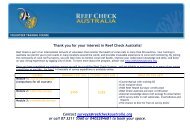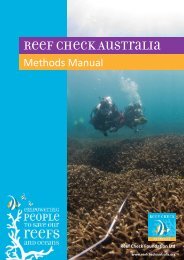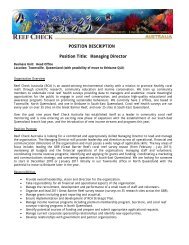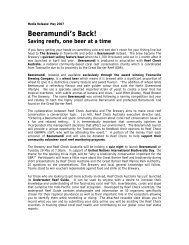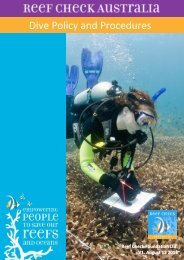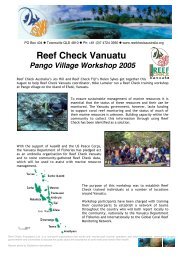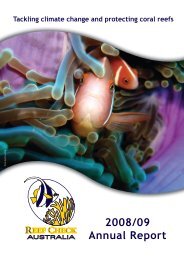Reef Check Australia Survey Methods
Reef Check Australia Survey Methods
Reef Check Australia Survey Methods
You also want an ePaper? Increase the reach of your titles
YUMPU automatically turns print PDFs into web optimized ePapers that Google loves.
This cycle of physical disturbance–decline–recovery is natural for coral reefs. These naturaldisturbances play an important role in shaping the ecosystem structure that we see.It is important that we understand how reefs change naturally so that we can determinehow human impacts may affect them.A healthy coral reef will naturally decline and recover in cycles through time. The health of acoral reef can be explained in terms of its resilience to impacts, such as its ability to recoverafter disturbance. We can measure this health by monitoring how coral reefs change overtime. A single survey will not tell us if a reef is healthy or not, because we would not know atwhat stage of decline or recovery the reef is at in terms of its dynamic balance (figure 3).aA model view of how a healthy coral reef willrecover following an acute natural impact, suchas a cyclone.% cover ofhealthyhard coralAcute natural impactcauses decline in % hardcoral cover.Following the impact, % cover ofhard coral will increase back to‘normal’ over 10-20 years.TimebA model view of how an unhealthy coral reefwill fail to recover fully through repeatedimpact events.% cover ofhealthyhard coralAcute natural impactcauses decline in % hardcoral cover.Following the impact, % coverof hard coral doesn’t fullyrecover and gradually declinesthrough time.TimeFigure 3a: dynamic balance of a healthy (resilient) coral reef; b: gradual decline of anunhealthy (non-resilient) coral reef.PO Box 404, Townsville, QLD 4810. Tel +61 7 4724 3950 www.reefcheckaustralia.org<strong>Reef</strong> <strong>Check</strong> Foundation Ltd. (<strong>Australia</strong>) ABN: 46 108 200 933Registered <strong>Australia</strong>n charity with tax deductible gift recipient status.
As the disturbance–recovery regime of a coral reef is complex, the longer the time-period forwhich we have monitoring data, the more disturbance-recovery patterns we can see. This willlead to a better understanding of how coral reefs can change over time.Monitoring is, therefore, important to help managers to understand which managementpractices (e.g. levels of fishing pressure or fertiliser run-off that are allowed) are sustainable(i.e. no damage to resources is caused) and which ones are unsustainable and cause a declinein coral reef health. Monitoring is an essential component to coral reef management.By monitoring our reefs each year, we’ll be helping scientists understand howhuman activities affect reefs into the future.Table 1: Coral and Substrate Indicators and Codes<strong>Reef</strong> <strong>Check</strong> Substrate CodesReasonHC – hard coralThe major building component of the reef.SC - soft coralNon-reef builder.SP - SpongeIndicator of sewage pollution if abundant.OT – otherNIA – nutrient indicator algaeNutrient pollution.RC - rockBare surface on which young coral can settle.RKC – recently killed coralIndicator of recent disturbance.SI – siltIndication of sedimentation.SD – sandRB - rubbleIndication of dynamite damage or stormdamage.PO Box 404, Townsville, QLD 4810. Tel +61 7 4724 3950 www.reefcheckaustralia.org<strong>Reef</strong> <strong>Check</strong> Foundation Ltd. (<strong>Australia</strong>) ABN: 46 108 200 933Registered <strong>Australia</strong>n charity with tax deductible gift recipient status.
Table 2: Coral and Substrate Growth Form CodesHARD CORALSGrowth FormsHCBR: Branching Hard CoralHCF: Foliose Hard CoralHCM: Massive Hard CoralHCE: Encrusting Hard CoralHCP: Plate Hard CoralHC: gathers other growth forms (digitate, columnar, etc.)SOFT CORALSRECENTLY KILLEDCORALROCKSPONGESHCB: Bleached Hard CoralSCL: Leathery Soft CoralSCZ: ZoanthidsSC: Other Soft Coral (tree or flower shaped)SCB: Bleached Soft CoralRKCTA: Recently killed coral covered with Turf AlgaeRKCNIA: Recently Killed Coral covered with NutrientIndicator AlgaeRKC: Recently killed coral (non covered with algae)RCTA: Rock covered with Turf AlgaeRCCA: Rock covered with Coralline AlgaeRC: Rock (non covered with algae)SPE: Encrusting spongeSP: All other spongesFISH, INVERTEBRATE AND IMPACT SURVEYSThese surveys are conducted using the same transect as the substrate survey, however, thistime the transect is 5 m wide. This is called a belt transect.Invertebrate and fish survey:These indicators represent economically orecologically important invertebrates and fishes. Seetable 3 for a list of these indicators and why theyhave been selected. Economically important speciesare important for fisheries. Ecological indicators areimportant for the health of the coral reef system.Examples of ecological indicators are Diadema sp.urchins, which are important algae grazers. Theabsence of algae grazers can cause prolific algaegrowth and a change in the state of the coral reeffrom a coral-dominated state to an algae-dominatedstate. Crown-of-thorns starfish are also ecologicalindicators and are coral-eating predators. Theirpresence in large numbers can reduce hard coral cover, providing more space for growth ofalgae and other invertebrates.The presence or absence of these indicators does not necessarily mean there is a problem on areef-by-reef scale. However, providing scientists with an overview of where they occur canhelp them to understand changes to coral reefs over time and analyse the potential cause ofthreats to coral reef health.PO Box 404, Townsville, QLD 4810. Tel +61 7 4724 3950 www.reefcheckaustralia.org<strong>Reef</strong> <strong>Check</strong> Foundation Ltd. (<strong>Australia</strong>) ABN: 46 108 200 933Registered <strong>Australia</strong>n charity with tax deductible gift recipient status.
Table 3: Invertebrate and fish IndicatorsIndicatorsOverfishingDynamiteFishingCyanideFishingCurioCollectionAquarium FishCollectingPollution e.g.fertilizer orsewageCoral damageInvertebratesBanded coral shrimp (Stenopus hispidus)Crown-of-thorns starfish (Acanthasterplanci)Spiny lobster (Panulirus spp.)XLong-spined black sea urchins (Diademaspp.)Giant clams (Tridacna spp.) X XPencil urchin (HeterocentrotusXmammilatus)Sea cucumbers (Thelenota ananas,XStichopusChloronotus, Holothoria edulis)XX?*XTriton (Charonia spp.) X XDrupella spp. snailsTripneustes spp. urchins X XTrochus (Trochus niloticus) X XAnemoneXXFishButterfly fish (Chaetodontidae) X X X**Grouper (>30 cm) (Serranidae) X X XBarramundi cod (Cromileptes altivelis) X X X XSnapper (Lutjanidae) X X**Humphead wrasse (Cheilinus undulates) X X X XParrotfish (>20cm) (Scaridae) X X X XBumphead parrot (BolbometoponX X X Xmuricatum)Sweetlips (Haemulidae) X X X XMoray eel (Muraenidae) X X*Scientists think there may be a link between crown-of-thorns starfish outbreaks and nutrientpollution (Brodie et al, 2005).**Note that all grouper > 30 cm and sized to the nearest 10 cm are counted. Maori wrasse andbumphead parrotfish that are off the transect area recorded because the transect length isinsufficient to capture true populations of these large fish which have a large range.PO Box 404, Townsville, QLD 4810. Tel +61 7 4724 3950 www.reefcheckaustralia.org<strong>Reef</strong> <strong>Check</strong> Foundation Ltd. (<strong>Australia</strong>) ABN: 46 108 200 933Registered <strong>Australia</strong>n charity with tax deductible gift recipient status.
Impact survey:Any visible impact on the reef is recorded during this survey. See table 4.Table 4: Impact IndicatorsImpactCoral damage: boat/anchorCoral damage: dynamiteCoral damage: otherTrash: fish netsTrash: generalBleaching (% of coral population)Bleaching (% of colony)Disease (% presence of disease of coralpopulation)Drupella sp. scarsCrown-of-thorns starfishOther scarsPHOTO SURVEYOur volunteers take photos of any of the impacts they see, such as coral bleaching or diseaseso that we can ensure our data are accurate and can be checked by a scientist at a later date.Photos are also taken of the dominant algae types found on the survey in order that scientistscan review which species are involved with anyoutbreaks recorded.VIDEO SURVEYThis survey provides a permanent record of the coraland substrate on the transect. This information may beimportant for future, more detailed (speciesidentification) analyses of the data at sites whereinteresting changes have been recorded by ourvolunteer researchers.WHAT HAPPENS TO THE DATA?All our data is sent to <strong>Reef</strong> <strong>Check</strong> Headquarters where it is integrated into a global database(see www.reefcheck.org). We also store our data in <strong>Australia</strong> so that it can be made availableto <strong>Australia</strong>’s scientists and managers. We currently show our substrate data sets throughGoogle Earth. The Google Earth layer can be downloaded from our website:http://www.reefcheckaustralia.org/research/data/index.cfmWe are currently setting up systems to make our data (both observational and digital) availableto scientists through an online database. Our data set will become more and more importantPO Box 404, Townsville, QLD 4810. Tel +61 7 4724 3950 www.reefcheckaustralia.org<strong>Reef</strong> <strong>Check</strong> Foundation Ltd. (<strong>Australia</strong>) ABN: 46 108 200 933Registered <strong>Australia</strong>n charity with tax deductible gift recipient status.
for the longer we collect it because we are interested in long-term trends as well as providingmanagers with an ‘early warning’ of particular impacts, e.g. the incidence of coral bleachingand disease. We also anticipate our data will help support local reef users to meaningfullycommunicate to scientists and managers the changes they see occurring on their local coralreefs.HOW DO YOU INTERPRET REEF CHECK RESULTS?The following information will help you understand how to interpret the data we collect. Werecommend you read this prior to reading our results.Ecological samplingBecause we cannot survey every square centimetre of a coral reef, we sample small sections.We carefully select these sections to be representative of the part of the reef and the scalethat we are interested in. For 1 <strong>Reef</strong> <strong>Check</strong> survey our scale is very small and we interpret ourdata at the scale of a dive site or < 1 km of reef. Where we are able to survey up to 3 <strong>Reef</strong><strong>Check</strong> sites per location we are able to increase our confidence with interpretation to 1 km ofreef.Do we take into account differences between observers?It is important for all environmental monitoring, that we ensure all observers identify andrecord what they see and accurately and reliably. However, it is impossible to ensure that allobservers will identify things exactly the same 100% of the time. This means that some of thedifferences recorded each year may be due to differences in observations rather thandifferences on the coral reef.We keep the identification of our target organisms similar between observers by rigorouslytesting our volunteer researchers who are all required to get 95% or higher in identificationtests. The other source of potential error is the redeployment of the transect tape by differentvolunteers each year. The volunteers follow a map of where the survey area is but they areunlikely to lay the tape in exactly the same place. This is called the deployment effect. Astudy to look at the observer effects of <strong>Reef</strong> <strong>Check</strong> volunteers found that differences betweenobservers and subsequent transect deployments are pretty low. This means with adequatetraining and suitable maps, people who are not marine biologists can be trained to collectuseful information.How do we present our data?We present our data as graphs. The graph below (figure 4) is an example of the substrate andcoral data for a single site over a period of 3 years. You can see that the site has not changedmuch during this time. The small changes that you can see may be due to slight differences inwhere the transect was laid and observer error, however the trend for a slight increase in hardcoral cover appears real because this trend appears across a number of years.PO Box 404, Townsville, QLD 4810. Tel +61 7 4724 3950 www.reefcheckaustralia.org<strong>Reef</strong> <strong>Check</strong> Foundation Ltd. (<strong>Australia</strong>) ABN: 46 108 200 933Registered <strong>Australia</strong>n charity with tax deductible gift recipient status.
Figure 4: An example coral and substrate graph.Precision of our dataPrecision is repeatability. This means that a repeat of a survey should yield the same results(assuming you do one survey immediately after the other and the coral reef hasn’t changed atall!). We need to collect precise data in monitoring so that we can be sure that any differenceswe see from one monitoring period to the next (e.g. annual monitoring periods) is due toactual change on the coral reef. It is not possible for anyone to collect 100% precise data butthere are things that we can do to increase our precision. These include:µ Rigorous training and testing of our volunteers to ensure that everyone can identify everythingcorrectly;µ Increasing the number of <strong>Reef</strong> <strong>Check</strong> transect sites per <strong>Reef</strong> <strong>Check</strong> survey site where possible.We cannot collect 100% precise data, so we cannot detect very slight changes in theenvironment because we cannot be sure that slight changes that we record are due toenvironmental change or lack of precision. See the final section on ‘how do you interpret <strong>Reef</strong><strong>Check</strong> results’ for more information on this topic.What is Standard Error?In the graph above, the mean percentage cover is calculated from the 4 transect replicates.Standard error (SE) tells us how accurately our data represents the study site.Error bars are important as they tell us how reliable (or repeatable) the data is.Where SE bars are high, the spatial variation in percentage cover of the various substratecategories is high and the overall figures for percentage cover that we obtain from the studyare less precise in terms of how well they represent our study site. Where SE bars are low, ourconfidence in the data increases.PO Box 404, Townsville, QLD 4810. Tel +61 7 4724 3950 www.reefcheckaustralia.org<strong>Reef</strong> <strong>Check</strong> Foundation Ltd. (<strong>Australia</strong>) ABN: 46 108 200 933Registered <strong>Australia</strong>n charity with tax deductible gift recipient status.
To increase precision at selected sites we aim to collect data from up to 3 <strong>Reef</strong> <strong>Check</strong> transectsites at each reef survey site (figure 2). This means we will have more transect replicates,survey more of the reef and our data will better represent our study site. This is why for some<strong>Reef</strong> <strong>Check</strong> survey sites we have combined the data from 2 or more <strong>Reef</strong> <strong>Check</strong> transects.Where SE error bars overlap from year to year there is no statistically significant difference inthe results, even if the results (e.g. percent cover) are different. Where error bars do notoverlap there may or may not be statistical differences in the data and further statistical testsare required to determine this. However, it is important to remember we are interested inwhether differences are ecologically significant at the end of the day.If we see a small change in percent cover of substrate, what does this mean?For the substrate survey it is important to take into account that slight alterations in transectplacement between each survey period and observer error may account for slight differencesbetween percentage cover of particular categories from year to year. Our measures of dataprecision show that we cannot determine differences in percent cover within a 5% range, butdifferences within the 10% range are likely to indicate real changes when looking at data fromone year to the next. Where there are long term data sets it is possible to look at the generaltrend to determine if a small increase or decrease from one year to the next is likely to be realor not.If we see large changes in percent cover of substrate, what does this mean?If we see a large difference in the percent cover of a substrate we will first look at our siteinformation and other survey data to try to make sense of it. For example, if hard coral coveris drastically reduced and we see from the invertebrate survey that crown-of-thorns starfishabundance is high, then we know to relate the reduction in hard coral to starfish predation.However, the reason for fluctuations may not always be apparent, it may be short-lived, e.g.algal blooms, and they may not be serious.So to increase our understanding of patterns of change, it is very useful to monitor sitesthrough the long-term. Such studies also help us to determine if any changes that we areconcerned about e.g. reduced coral cover, continue to get worse, fail to recover to theirprevious amount or are just fluctuating in a cycle (see figure 3 – the dynamic balance of coralreefs).<strong>Reef</strong> <strong>Check</strong> results are meaningful on a long-term scale, rather than from a singlesnapshot in time.PO Box 404, Townsville, QLD 4810. Tel +61 7 4724 3950 www.reefcheckaustralia.org<strong>Reef</strong> <strong>Check</strong> Foundation Ltd. (<strong>Australia</strong>) ABN: 46 108 200 933Registered <strong>Australia</strong>n charity with tax deductible gift recipient status.
Does low hard coral cover mean our dive site is unhealthy?Remember that cycles of decline and recovery are natural for coral reefs. We get concerned ifa reef declines and does not recover, which is why we need long-term monitoring. Forexample, coral cover at a site may decline due to crown-of-thorns starfish predation or cyclonedamage. The hard cover percentage cover will decline with this impact, but on a healthy reefcoral cover will increase again over the next 10 years as the site recovers. This cycle has beenrecorded for a number of reefs on the Great Barrier <strong>Reef</strong> that have been affected by crown-ofthornsstarfish outbreaks.Natural disturbance is important in sustaining species diversity.Natural disturbance is important on coral reefs where corals (and other animals and plants)compete with one another for space. Cyclones and crown-of-thorns starfish will tend to wipeout delicate coral growth forms, such as branching or plate coral. These delicate corals tend tobe faster growing and out-compete the more robust species for space. These impacts,therefore, give the more robust corals a chance to grow and promote species diversity (andhealth) of coral reefs.Remember, if we see a decline in coral cover, we are most interested in whether percentcover increases again in the future.It is also important to remember that some reefs may support a high percent cover of hardcoral and others will not - naturally. Therefore it is not important how much coral a reef has,but how it reacts over time to its environment. Healthy coral reefs with low coral cover canhave a stunning array of fish and invertebrate life!If we don’t have some of the indicators is there a problem?The presence or absence of one or several indicators does not mean there is a problem. Theabundance of some of the indicators, particularly invertebrates, will naturally vary from reef toreef. Each site will be unique in its ecological make-up. Therefore, long-term data for each siteis important for us to determine if our reefs are changing.In addition to variations from reef to reef, many of the target invertebrates and fish are highlymobile and their abundance in a particular part of a reef changes through the day as well asacross seasons. A single <strong>Reef</strong> <strong>Check</strong> survey is not sufficient to fully characterise fish or mobileinvertebrate populations at a site but rather provide a snapshot of what is there. Thereforethese data must be interpreted with care.For long-term studies, however, we will become concerned when invertebrates and fish thatused to be present at a local scale are no longer there.PO Box 404, Townsville, QLD 4810. Tel +61 7 4724 3950 www.reefcheckaustralia.org<strong>Reef</strong> <strong>Check</strong> Foundation Ltd. (<strong>Australia</strong>) ABN: 46 108 200 933Registered <strong>Australia</strong>n charity with tax deductible gift recipient status.
DisclaimerThe <strong>Reef</strong> <strong>Check</strong> protocol was designed for use by volunteer divers and snorkellers to monitorbasic and globally applicable indicators of reef health. Small-scale fluctuations cannot bedetermined from <strong>Reef</strong> <strong>Check</strong> data, which is designed to detect broad changes through the longterm.All <strong>Reef</strong> <strong>Check</strong> <strong>Australia</strong> volunteer researchers complete a rigorous training course and aretested on their identification skills and must achieve a pass mark of 95% before they collectdata. <strong>Reef</strong> <strong>Check</strong> volunteers are responsible for carrying out the surveys to the standards bywhich they have been taught. However, <strong>Reef</strong> <strong>Check</strong> accepts no responsibility for the accuracyof the data, or for use of <strong>Reef</strong> <strong>Check</strong> data beyond a broad-brush, early warning system ofchange at monitored sites.PO Box 404, Townsville, QLD 4810. Tel +61 7 4724 3950 www.reefcheckaustralia.org<strong>Reef</strong> <strong>Check</strong> Foundation Ltd. (<strong>Australia</strong>) ABN: 46 108 200 933Registered <strong>Australia</strong>n charity with tax deductible gift recipient status.
USEFUL REFERENCESBrodie, J., Fabricius, K., De’ath, G., Okaji, K., 2005. Are increased nutrient inputs responsiblefor more outbreaks of crown-of-thorns starfish? An appraisal of the evidence. In: Hutchings,P.A., Haynes, D. (Eds.), Proceedings of Catchment to <strong>Reef</strong>: Water Quality Issues in the GreatBarrier <strong>Reef</strong> Region Conference. Marine Pollution Bulletin.µ For more information on coral reefs see http://www.reef.crc.org.au/discover/µ For more information on reef management see http://www.gbrmpa.gov.auHOW DO YOU GET INVOLVED?You can get involved by coordinating your own <strong>Reef</strong> <strong>Check</strong> team, teaching <strong>Reef</strong> <strong>Check</strong> TrainingCourses or becoming a <strong>Reef</strong> <strong>Check</strong> researcher. Information on our training certificationrequirements is below:<strong>Reef</strong> <strong>Check</strong> <strong>Australia</strong> volunteer researcherµ Pass the <strong>Reef</strong> <strong>Check</strong> <strong>Australia</strong> Training Course;µ Rescue Diver (you can do our training course as an advanced diver);µ Current CPR and first aid;µ Current dive accident insurance.<strong>Reef</strong> <strong>Check</strong> Trainerµ Pass the <strong>Reef</strong> <strong>Check</strong> <strong>Australia</strong> Training and Site Selection Course;µ Scuba instructor (Scuba Dive International – crossovers are easy);µ Current CPR and first aid;µ Current instructor insurance;µ Current oxygen provider certification.<strong>Reef</strong> <strong>Check</strong> Coordinatorµ Experience with coordinating volunteer groups;µ Experience with coordinating dive groups.For more information contact: support@reefcheckaustralia.orgPO Box 404, Townsville, QLD 4810. Tel +61 7 4724 3950 www.reefcheckaustralia.org<strong>Reef</strong> <strong>Check</strong> Foundation Ltd. (<strong>Australia</strong>) ABN: 46 108 200 933Registered <strong>Australia</strong>n charity with tax deductible gift recipient status.
PO Box 404, Townsville, QLD 4810. Tel +61 7 4724 3950 www.reefcheckaustralia.org<strong>Reef</strong> <strong>Check</strong> Foundation Ltd. (<strong>Australia</strong>) ABN: 46 108 200 933Registered <strong>Australia</strong>n charity with tax deductible gift recipient status.




